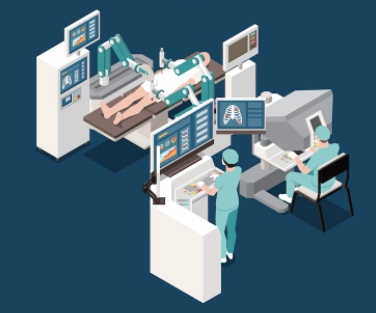

Imagine needing surgery for a rare condition and being able to have it performed by a highly specialized surgeon operating via robotic surgery from thousands of kilometers away. Dr. Warren Lo , Consultant Urologist at Gleneagles Hospital Kuala Lumpur, explains how this is now possible
Such a scenario is possible today with robotic surgery. Not So Long Ago, Robotic surgery was first introduced to the world in 2000 (and came to Malaysia only 3 years later). It was pioneered in urological cancer surgeries, such as prostate cancer surgeries, followed by kidney and bladder cancer surgeries.
This method then made its way to other areas, like functional and reconstructive surgeries, such as pelvic organ prolapse and severe urinary incontinence, using mesh or an artificial urinary sphincter. The method is now gaining traction in other surgical disciplines such as colorectal, ENT, cardiothoracic, and gynaecology.
Robotic surgery is a type of minimally invasive surgery that uses a robotic system to assist surgeons in performing procedures with greater precision, flexibility, and control. The system typically includes a console where the surgeon controls robotic arms with surgical instruments, which are guided by a high-definition, 3D view of the surgical site. It offers benefits like reduced pain, smaller scars, less blood loss, and faster recovery. Now, this technology allows specialists to guide surgeries remotely, even from thousands of kilometers away, making world-class care accessible from anywhere.
Today, there are already more than 5,600 robots in 67 countries, with more than 7,200,000 procedures performed. About 80 percent of prostate cancer surgeries are done robotically in the US and 70 percent in the UK.
According to an article published in the Laparoscopic, Endoscopic and Robotic Surgery journal in 2019, a mathematical model was created to compare robotic and standard laparoscopic procedures and to determine the more effective surgical treatment from a patient's point of view, thus assisting the patient in making the right decision. The robotic approach clearly stood out as the preferred option of the two studied surgeries (prostate and lung).
One of the recent innovations in robotic surgery, and one that takes it to another level, is Augmented Reality (AR). AR allows us to visualise a real-life environment with a digital augmentation overlaid on it. A simple example of an AR program allows an interior designer to visualise what a room looks like when it is filled with the desired furniture and fittings.
AR helps in remotely guided operations, where an expert in one part of the world can visually guide surgeons on another continent to perform surgeries in real-time and without the necessity of physical presence. It is also used as a platform for teaching, where junior surgeons can learn the intricacies of surgical procedures without crowding an actual surgery and risking breaching the sterility of the operation theatre.
The innovative solution, known as Proximie, was used for the first time in 2018 during a robot-assisted procedure at Guy’s Hospital, London. This technology has been used in many parts of the world, including Vietnam, Ecuador, Mexico, and South Africa, linking surgical teams to experts located in the United Kingdom or the USA. This pioneering technology, which literally allows surgeons to transport themselves into an operating theatre anywhere in the world, has even helped doctors in war zones.
Professor of Robotic Surgery and Urological Innovation at King’s College London, Mr Prokar Dasgupta, is a big proponent of AR. Professor Dasgupta uses the technology to instruct colleagues as they perform robotic surgery without his needing to be present in the operating theatre.
This software allows Professor Dasgupta to see the operations in detail on his laptop. He verbally instructs his robotic surgical team using the software, which then broadcasts to him through speakers in the operating theatre. A video screen in the operating theatre also allows his colleagues to watch Professor Dasgupta use his hands and fingers to indicate where to make incisions and what to avoid with the robot arm. While his colleagues have control of the surgical robot’s movements. The technology enables the surgeon to perform the surgery as precisely as the Professor would have wanted from his knowledge and experience.
The true advantage of AR here is that it can allow even complex operations to take place at a moment's notice without the hassle of travel. Irrespective of location, patients receive the best available expertise, even when the area is not immediately accessible. Ultimately, this means that procedures are safer and properly guided, and patients receive the best care possible.
Innovations like augmented reality (AR) and robotic surgery are transforming healthcare by eliminating geographical and logistical barriers to treatment. Through Proximie’s AR-assisted remote collaboration platform, patients no longer need to wait long periods or travel far to get the help they need. Aided by the latest mobile tools and gadgets, a consultant surgeon can perform complex surgeries from anywhere in the world, enabling patients to receive the best treatment without ever leaving their hometowns.
At Gleneagles Hospital Kuala Lumpur, we are committed to providing cutting-edge healthcare solutions through innovative technologies like robotic surgery, augmented reality, and remote surgery platforms. Our goal is to break down geographical barriers and ensure that every patient, regardless of location, has access to the best medical care available.
Whether you need complex surgery or specialized treatment, our team of expert surgeons is here to provide you with the most advanced and precise care possible. Experience the future of healthcare at Gleneagles Hospital Kuala Lumpur, where world-class care is just a step away.
Contact us today to learn more about how our robotic-assisted surgeries and AR-guided procedures can help you receive the best care without ever leaving your hometown.
Gleneagles Hospital Kuala Lumpur

Wait a minute

Wait a minute